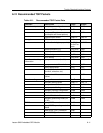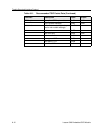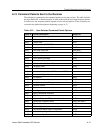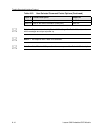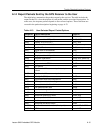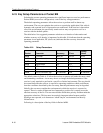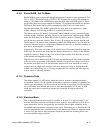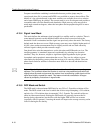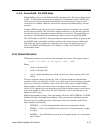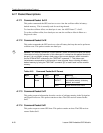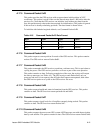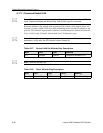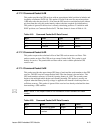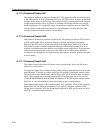
Lassen-SK8 Embedded GPS Module A-17
Trimble Standard Interface Protocol
A.15.1 Packet 0xBB - Set Fix Mode
Packet 0xBB is used to choose the appropriate position fix mode for your application: 2-D,
3-D or AUTO. The default mode is AUTO 2-D/3-D, where the receiver first attempts to
obtain a 3-D solution with a PDOP below both the DOP mask and DOP switch. If this is
not possible, then the receiver attempts to obtain a 2-D solution with a DOP less than the
DOP mask. This mode supplies fairly continuous position fixes even when there is
frequent obscuration. This mode is preferable for most land or air applications, where
altitude changes are occurring and there is occasional obscuration.
The highest accuracy fix mode is 3-D manual, where altitude is always calculated along
with the latitude, longitude, and time. However, this requires four satellites with a PDOP
below the DOP mask set in Packet BB in order to obtain a position. Normally, this will
provide the most accurate solution. Thus, if only 3-D solutions are desired, then the user
should request 3-D manual mode. Depending on how the PDOP mask is set, this may be
restrictive when the receiver is subjected to frequent obscuration, or when the geometry is
poor due to an incomplete constellation.
Alternatively, if the user only wants a 2-D solution, then 2-D manual should be requested.
In this case, the receiver uses either the last altitude obtained in a 3-D fix, or the altitude
supplied by the user. However, any error in the assumed altitude will affect the accuracy
of the latitude and longitude solution.
High accuracy users should avoid the 2-D mode and should expect fixes with accuracies
which are at best as accurate as the supplied altitude. If a marine user enters sea-level as
the altitude, then small errors in the horizontal solution will occur when the sea state is
rough or there are high tidal variations. However, these errors may be smaller than the
altitude errors induced by SA, so 2-D may be preferable for a marine user who does not
want to observe “unusual” altitudes.
A.15.2 Dynamics Code
The feature default is LAND mode, where the receiver assumes a moderate dynamic
environment. In this case, the satellite search and re-acquisition routines are optimized for
vehicle type environments. In SEA mode, the search and re-acquisition routines assume a
low acceleration environment and reverts to user entered altitude in 2-D auto. In AIR
mode, the search and re-acquisition routines are optimized for high acceleration
conditions.
A.15.3 Elevation Mask
This is the minimum elevation angle for satellites to be used in a solution output by the
receiver. Satellites which are near the horizon are typically more difficult to track due to
signal attenuation, and are also generally less accurate due to higher variability in the
ionospheric and tropospheric corruption of the signal. When there are no obstructions, the
receiver can generally track a satellite down to near the horizon. However, when this mask
is set too low, the receiver may experience frequent constellation switching due to low
elevation satellites being obscured.





